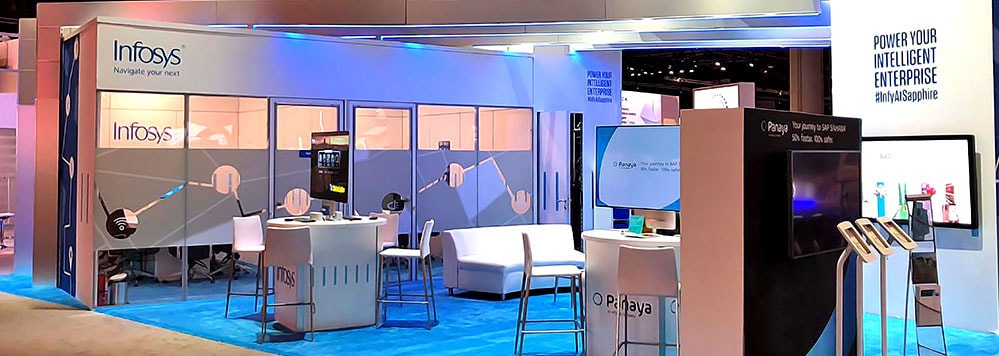Foreword

Dinesh Rao
EVP – Head Global Services Enterprise Package Application Services, Infosys
This year SAPPHIRE NOW attendees gathered in sunny Orlando for more than just an information conference. They celebrated 30 years since SAP pioneered a new brand of customer interaction at its first SAPPHIRE event.
Infosys used this anniversary celebration to showcase solutions, tools, accelerators, methodologies through immersive experiences that help enterprises accelerate their digital transformation journey. Our experts showcased our SAP offerings and capabilities and innovative industry use cases that leverage automation and machine learning to make enterprises intelligent and agile.
We hosted panels on multiple topics, from building self-service supplier portals to sowing the seeds of digital success with integrated business planning. During these joint sessions, clients shared their digital transformation journey. They explained how Infosys partnered with them to plan and execute their transformation journey and enabled them to build intelligent, agile systems. These programs simplified and automated the process landscape, driving operational excellence and delightful customer experience.
These panels validated that strategic discussions like these are needed so companies learn from each other as they strive to succeed in the digital economy. The conference sessions also showed how the digital revolution continues to reshape our economic landscape. It’s become more important than ever for industry leaders, policy makers and academics to have an open forum in which to discuss these transformations and the impact they are having locally and around the world.
SAPPHIRE NOW saw over 25,000 executives from different geographical areas gathering to celebrate 30 years of solutions in the SAP ecosystem. The three-day event was a success thanks to many Infoscions and our amazing panelists. We share articles from our SAPPHIRE NOW sessions and hope you will find as much value in them as those who attended the sessions.
Lessons learned: first digital conversion in Brazil
Eurofarma is a major pharmaceutical company headquartered in Brazil. With locations in 20 countries, it covers 87% of Latin America. The company carries 355 brands and 844 forms, offering customers both prescription and generic drugs, over-the-counter medication and other health care products.
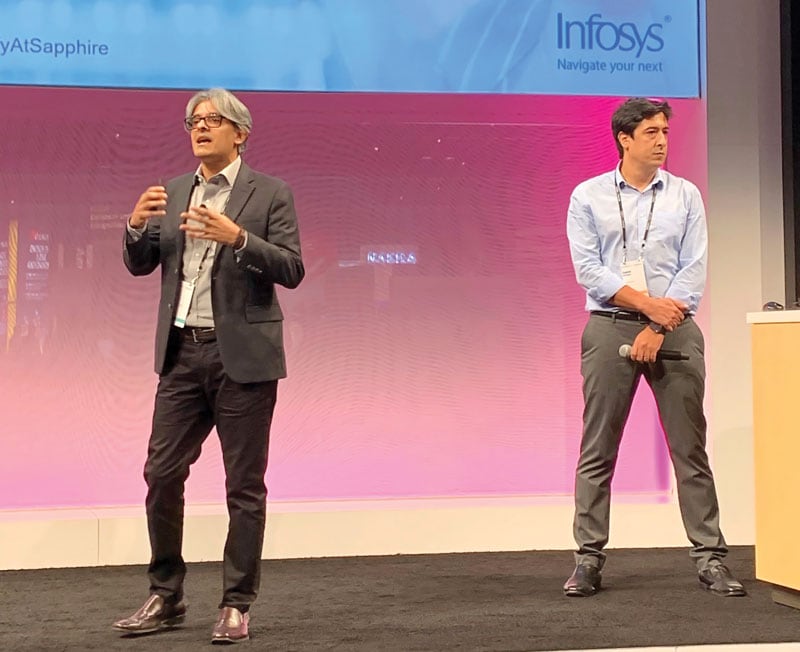
This pharmaceutical company truly believes in innovation. In fact, almost 10% of the company’s revenue goes to research and development, with a goal of increasing R&D by another 5% by 2030.
Although the company thrived for many years, the industry changed, and Eurofarma knew it had to evolve to stay competitive. Rising drug development costs, 10-year drug release cycles and increased competition convinced it that transformation was needed to continue its history of success.
“There are few industries that are as regulated as pharmaceutical companies,” said Avi Mehta, associate partner with Infosys Limited. “And now they have to address the trend of patient-centric health care, where medicines are personalized to smaller groups.”
These challenges required decisive action, but the question was how to address it.
“Eurofarma decided to implement a new digital platform to support its transformation,” Mehta said. “S/4HANA was chosen for that purpose, and Eurofarma expects a tool which is flexible enough to support future business model changes caused by changed expectations regarding speed, integration, insights and mobility.”
Once the decision was made to transition to S/4HANA, a number of questions were asked that would eventually need answers. First, the program leaders needed a strategy to decide whether to implement a new system — and whether conversion was even the correct route for this project. The decision-making process included evaluation of six dimensions: deployment strategy, business processes, project nature, historical data, solution investment and user experience.

“While you can go ‘big bang’ or use phased implementation, business strategy must drive implementation approach, not the opposite. For conversion, a big-bang, all-at-once approach is required due to the overwhelming complexity of activities and dependencies involved.”
With business processes, implementation means the focus is on redesigning the processes. In a conversion, it’s more about retaining what you have and leveraging it.
After a thorough assessment, Eurofarma ultimately decided on a S/4HANA conversion. This was the first SAP HANA conversion in Brazil, and it was designed to give the company better business processes and real-time action.
Historical data was important since Eurofarma possessed 15 years’ worth of data. In a “greenfield” implementation, companies normally use only open items as their historical data. Conversion means having all items available.
“While implementation is transformational, it also means minimum reuse of your earlier investment in enterprise applications. Though conversion is more tactical, it does allow maximum reuse and less disruption to the business,” he added.
These project guiding principles provided a framework for making the right decision for this enterprise.
“Once you are convinced that conversion is the path, it might be useful to use a simple checklist to confirm your decision. Conversions are better for environments with mature processes, with limited need for redesign,” said Mehta.
The checklist summarizes what the company already has with their expectation from the ERP transition. Eurofarma needed to minimize the involvement of business areas to reduce organizational impacts and business continuity risk.
Before running S/4HANA conversion project, Eurofarma conducted a separate project, where they migrated their database to SAP HANA database.
“We decided to make two projects out of it,” said Daniel Ferreira, CIO of Eurofarma. “First, we moved SAP ECC to HANA database, then we started the S/4HANA conversion project.” This two-project approach reduced the difficulty to gain the learning curve while delivering the project without endangering benefits like database size reduction and simplifications.
Before initiating the S/4HANA project, an assessment was conducted to evaluate whether the company was ready for conversion. To support this assessment, an Infosys tool called ‘S/4 Assist’ was used.
“S/4 Assist is an app that gathers information about the current system. Its output provides a good idea of actions needed, corrections required prior to conversion, and what adjustment in configurations and also in developments you must make before converting,” explained Mehta.
The actual conversion process did require numerous cycles to get it right on the front end. Four conversion cycles were executed in a separate environment called sandbox. Then the same process was repeated in the development and quality environments, which included integration tests too. In the end, cutover was performed and the new system transitioned to production without major issues.
The conversion process was broken down into three steps. “The first one is pre-conversion and is done in SAP ECC. Basically, this requires adjustments to data and configurations,” explained Mehta. “After that, conversion and post-conversion activities such as code remediation and data migration happen in S/4HANA.”
The process was not without challenges. Each time a problem was discovered, the process came to a halt and adjustments were made before restarting the conversion again. It took a year to accomplish a successful conversion and the assessment took a month to complete. The sandbox had four cycles and therefore required more time, but because it happened in a testing environment, it did not disrupt company´s operations.
“After completing the sandbox cycles, we moved through development, quality and production environments in only three months,” Mehta pointed out. During this period, the system was ‘frozen’ for changes, and there was three days of downtime during the cutover.”
In the end, Eurofarma was able to establish the foundation for its digital transformation as planned. In terms of project numbers: 76,000 clients and 84,000 vendors were converted to business partner, two thousand codes were adjusted and billions of pricing records were migrated. Although it streamlined processes, the new system didn’t significant change operations, requiring a low level of training efforts.
Through a careful assessment of their current state, along with clarity about future drivers and deployment models, Eurofarma chose the right approach and executed it with purpose. “Conversion projects require a strong account presence: not only during the implementation but in particular after Go-Live when subsequent and incremental innovation projects will happen on top of the successfully built foundation,” said Frank Dorr, managing partner LATAM with Infosys Consulting. With a successful platform in place, now the company can focus on their business: developing promising drugs and competing effectively in the market.
Making beauty easier with a self-service supplier portal
Is beauty truly in the eyes of the beholder, or can self-service technology lend a hand? Ulta Beauty is one of the largest beauty retailers in the United States and the premier destination for cosmetics, fragrances, skin care products, hair care products and salon services. As Ulta continued to broaden its offerings to meet consumer tastes, the company needed to update its supplier collaboration platform.
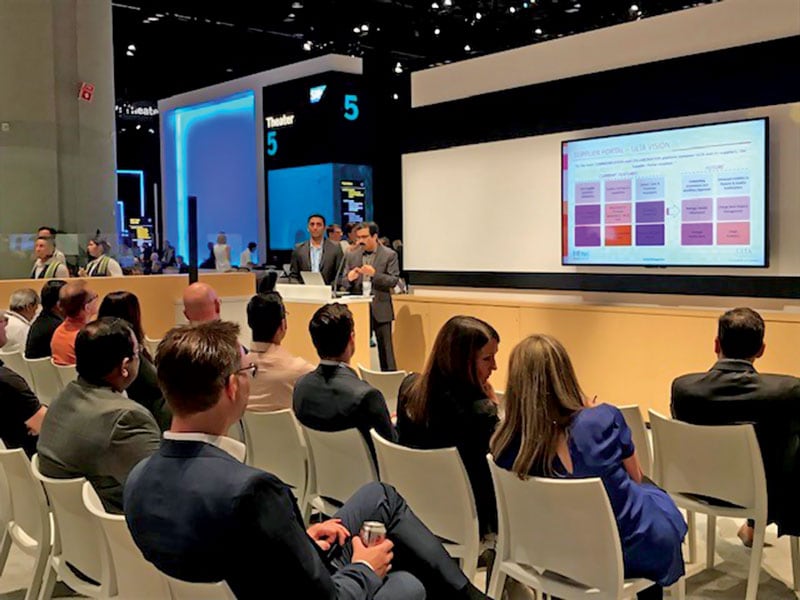
Ulta partners with more than 500 brands, including leading beauty brands, startup brands and the company’s private label of products sold in stores and online. With more than 1,000 stores and warehouses filled with over 25,000 products, the company wanted to move beyond traditional supplier management and establish a self-service capability.
“We lacked an ability to collaborate and finely share information with our suppliers,” said Srihari Gumastha, Ulta, senior director of information technology for supply chain and merchandising.
Collaboration improvement was the principal reason Ulta leaders decided to pursue the supplier portal. The beauty company wanted to incorporate suppliers into the overall supply chain experience, streamline their partnership and reduce manual work by Ulta associates.
After several workshops and design thinking sessions, Ulta selected SAP Cloud Platform to implement as the supplier portal. “We selected it because it gives us the ability with our own business teams to change landing page content,” Gumastha said about customizing the display for their suppliers. “The flexibility it gave us was pretty unique.”
As the main communication channel and collaboration platform between Ulta and its suppliers, the supplier portal needed to perform many tasks previously done manually by Ulta employees. Some of the major tasks included managing vendor information, onboarding new suppliers, managing profile data and publishing reports and scorecards.
The program team developed a three-phase implementation plan, starting with a foundation of fulfilling the most urgent and least dependent requirements. Ulta started with a standard integration system before adding some customizations, including integration with multiple SAP and non-SAP systems like Office 365 and Identity Provider. Several methods were integrated with the supplier portal through interfaces like web services, HTTP and Odata. Single sign-on was implemented for access across these systems.
The platform was able to publish alerts and provide tailored levels of access to end users. A document management platform was also required, since reports are frequently shared with suppliers and are an effective means of distributing information.
“Seamless onboarding was a key requirement, as was having secure access to shared records,” said Sujesh KC, Infosys senior technology architect for SAP New Technology Services. “We have used the standard user management engine of this cloud platform.”
The next phase was a more traditional approach in a project of this size. This included a process to improve the chargebacks process, which would help settle disputes faster, and to publish a chargeback report each quarter. “The chain management example and supplier rollout was good, and we brought in a pilot vendor to collaborate with us,” Gumastha explained.
Moving forward, the company plans to use SAP Jam for better collaboration, and SAP Leonardo to provide machine learning and help analyze data. This phase will also require integration with other on-premise systems for financial settlement, reports and quality systems.
“Our brand partners love this,” Gumastha said. “We already have 98% of suppliers onboarded, and our manual errors and interventions were reduced significantly.”
Ulta estimates a 90% reduction in manual effort spent sharing reports with brand partners. Data accuracy is better through supplier self-service functions.
Automated notifications and alerts will reduce delays by 100% for Ulta and its suppliers. This has resulted in a two-way collaboration that developed better trust between Ulta and its brand partners.
The process fits well with the program timelines and scope. Leaders believe the early design thinking work performed will help avoid surprises as the solution is adopted across their supplier base.
Ulta had a good idea of their requirements, so the program team was able to use standard approaches and programming with minimal customization.
“What has happened in previous projects is we built something and showed it to business users then at the end, they say they want something else,” Gumastha said. “We avoided that mistake on this program.”
As a result, the company delivered an enhanced user experience, rapid portal implementation and frequent cloud releases. Ulta has succeeded on this initiative through a combination of clear vision, management support, user-centricity and leveraging the capabilities of SAP Cloud Platform. The self-service system now allows partner brands to collaborate and communicate better with the beauty retailers. And that is something beautiful to behold indeed.
Undertaking the world’s largest implementation of SAP IBP
When serving the world’s farmers, integrated planning takes on a whole new meaning. Syngenta AG is a global agriculture company that helps feed a world that needs to grow more with less. The customers for their seeds and crop protection are farmers ranging from smallholder farms in emerging markets to mega farms in the United States. The work of the global science, innovation based company is vital as statistics show that by 2050 the numbers of farmers and farmland will decrease, but at the same time, the world will need 70% more food for the estimated 9 billion people populating the Earth.

With this compelling context, the company also faced a diverse business landscape with operations in 90 countries, so it is no surprise Syngenta’s situation is complex for both demand and supply. Their old model wasn’t working with the new global agriculture landscape, and that set Syngenta on a journey to ultimately undertake the world’s largest implementation of SAP’s Integrated Business Planning Solution.
“The business models that we cover for planning and forecasting are very, very diverse,” said Matt McCall, Syngenta global lead of integrated business planning. “Sometimes, it takes over a year to plan, execute and manufacture the active ingredients that go into our products, especially on the crop protection side.”
A long lead time coupled with a short window during the planting stage shows why the company needs a clear view of its operations. The company faces uncertainty when it comes to other effects on crops like commodity prices and weather.
“The regulatory environment is becoming more and more unstable as we’ve seen in the news where certain regions of the world are deciding what kind of products they want in their markets,” McCall explained. “There’s a lot of uncertainty on both the demand side and the supply side, which makes it very challenging.”
He acknowledges they forecast predominantly within their company. The sales force or marketing team is asked, “What do you think is going to happen?” and that drives the forecast of record. The results were sometimes disastrous, and the cost of lost sales could override everything else the company was trying to accomplish.
“We were having accuracy around 55% to 60%,” McCall said. This is a high-margin business and needed better planning capabilities because of all the challenges, along with significant problems.
“Lots of things were missing during integrated business planning,” said Nikhil Balkundi, Infosys senior industry principal. He said simple tasks were difficult because Syngenta’s system lacked basic functionality to complete them.
That was the main business driver and change catalyst for Syngenta to improve this area and select the SAP IBP solution. The implementation journey started in 2013 with just a shell of the invoice price variant and the ability to build what was needed.
“We had very regional or local planning process, toolsets and data,” McCall stated. “We had over 28 ways to create forecasts, and that wasn’t including the myriad spreadsheets in some of the large markets.”
He said the company had a fragmented process to collect information for planning and to forecast accurately. There were no specific goals, planning infrastructure or core systems in place to help the company improve.
“If we were going to invest in an IBP implementation, we wanted to make sure that we had specific contributions coming down to the business case,” McCall commented. “We needed to show visibility and transparency of information so we could have quicker, faster decision-making locally.”
The answer had to go up the global supply chain and target forecast bias reduction. Streamlining and improving forecast accuracy was a part of the business case, along with controlling inventory through better business metrics. Lastly, the company needed a harmonized process, with a toolset and a foundation to build their demand-planning capability.
They first defined a target operating model before deciding system or platform capabilities.
Leaders emphasize that defining the target operating model first was critical to their success.
This operating model definition then extended to the capabilities the platform needed to have. Syngenta leaders created an agreement on what the target operating model for demand planning and the forecasting process looked like.
The team discovered the process had five elements based on the company’s business challenges. Their first step was to remove forecast bias. That involved combining consensus forecasting and opinion consensus into a form of data that is easier to streamline.
Syngenta found they needed a different, faster way to collect data. By the time the team received the information, too much time had passed. The execution window for planting was narrow and there was sometimes a two-week delay to find out about market changes, which was too late. Syngenta’s goal was a four-working-day process to create the forecast.
“We needed to build organizational competencies so that the data inputs and the outputs were usable by everyone,” McCall said. “The same data set had to be used, with the same definitions and the same process of how you came to that definition. People were doing things in silos with different information and it was just not syncing together.”
Syngenta needed a statistical measurement approach to create an accountability method. Team members did not have the metrics and method to measure forecasts, which meant a lack of accountability. When given information to measure accuracy, the team observed, but no one did anything with the potentially negative results. The new system enabled action and accountability based on a process that required participation.
Knowing what they needed, team members used IBP as a platform to resolve those issues. This included processes and creating the right data to run in the background of the program to enhance its analytics and forecasting.
“Essentially, we have a process step now, enabled through IBP that allows everyone to rely on their planning and forecasting data within the cycle,” McCall said. After initial trial and errors, the new system significantly reduced time to prepare a proper demand planning forecasting process.
Planning the process was one thing. Implementing the solutions was viewed as the most significant and trickiest part.
Once the target operating model was defined, the team selected the tools they believed would deliver the capabilities. They knew their issues, process, data and computer needs were going to be unique, so they selected a tool they understood – SAP IBP – something the team felt they could influence and shape how functionality was delivered.
To test the results, the company picked a small, diverse market with several business models, encompassing the majority of models Syngenta uses globally. The team spent extra time to get this right. “That was probably the longest chunk of our roadmap to design the base system, picking that market and then working with them,” McCall commented.
Next, the team chose the biggest and most important markets to test as the example for the system’s scalability. The United States region was selected because of its major agricultural market. The U.S. already had a smooth process that worked and was a model for smaller global markets. These testing results made a smooth transition for the rollout.
“I don’t think in the history of our company, we have achieved the rollout speed that covered the entire base of our business in such a short period,” McCall said.
The Syngenta integrated business plan was a multiyear process, and it was such a large undertaking that some aspects were ushered in one phase at a time. First was the base program, which involved the integration of the old and new application.
The inputs and outputs were the same, the data models aligned, and it allowed the team to use analytics. IBP is powerful, but it requires process compliance, data standards and consistency across regions to achieve an accurate result maybe. The second stage took place in 2017, when the plan was put into action by having the initial team members become process champions and drive the program through remaining stages.
With a new system and new roles, implementing global statistical forecasting simultaneously would have been risky. Instead, the team delivered initial success in some major markets, providing proof points for a statistically-driven forecast process coupled with SAP technology.
Syngenta leaders consider the massive project a success even though it is still a work in progress. The IBP system improved the business cycle for this global agriculture company. The new solution also contributed to significant financial improvements. In the first year, the new system reduced forecast bias by 10% and achieved a 17% reduction in lost sales. While IBP has removed the weeds of forecast inefficiency, it has also planted the seeds of long-term financial success.
Digital utility transformation
The challenge was clear: A leading West Coast utility needed to transform its enterprise core systems if it wanted to develop the digital capacity necessary to continue its tradition as an innovative energy provider in an era of clean energy. The utility has over 10,000 employees who help provide service to more than 5 million customers.
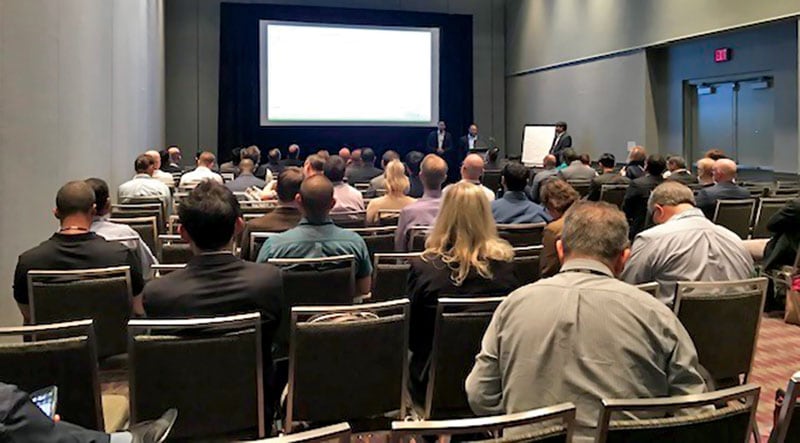
“Although our business is energy generation and distribution, we also have to be a system integrator, as well as a network service provider and maintainer.”
– Senior program manager at a leading West Coast utility
With an SAP enterprise core platform dating back to 2008 that is no longer fully and effectively utilized, the utility needed to transform. On its path to becoming a digital utility, the company launched multiple large parallel initiatives like grid modernization and customer service re-platforming, which also required a stable and high-performing enterprise core.
Phase one of the Enterprise Core Transformation program began in 2017 with a four-month S/4HANA assessment, roadmap and business case exercise. In the assessment, the firm’s officials and Infosys consultants determined whether SAP S/4HANA and SoH were feasible. This process started with determining current pain points and solution enablers with SAP S/4HANA.
This step involved preparing an impact analysis across seven dimensions: business process, configuration, custom code, interfaces, peripheral systems, organization change management and infrastructure.
The goals were to discover whether the process would improve the utility’s systems and to identify the business benefits of a new system. This also enabled the company to better understand implementation complexities.
The first phase also meant creating a road map with options and the ability to evolve. For the firm the following options were available: Suite on HANA, Suite on HANA with S/4 Finance 1605 add-on, and S/4HANA 1610 Enterprise Management.
A feasibility analysis was created for each option. After a great deal of comparison, the team determined that S/4HANA 1610 would not work because of the warehouse management add-on component on SAP ECC. The S/4HANA Finance 1605 option was not selected because some functionality the company needed for the SAP product road map was not initially available. Therefore, the utility recommended Business Suite on HANA as the platform of choice.
While company leaders selected Suite on HANA for functional and technical reasons, it was also important to make the business case to shape overall program plans. The business case preparation started with the identification of business value levers and operational levers. These benefits were essential to quantify and then achieve. It was also important to understand costs including infrastructure, product license and services expenses. Further, organizational change management was an important factor in the implementation program.
“The decision was really driven by the amount of change the organization could absorb at one particular time,” the program manager said.
The team created a list of business and technology objectives as part of the enterprise core transformation program. The company had to think about the age of its systems. Some problems it faced included hardware that had reached the end of its life, older technologies that needed replacing, and the fact that the company needed upgrades in SAP. “We also had to deal with technology obsolescence,” the program manager said. “We were on a five-year technology refresh cycle, and we were coming right up against that.”
Another objective was to find ways to simplify the large technology landscape already in use. What was needed was a way to consolidate applications, reduce the number of instances, and reduce complexity in the different environments. “We have a very complex landscape with 14 SAP applications” the program manager admitted. “We had multiple operations that we had to support and enable at Edison. This meant portfolio rationalization had to take time, and for us it has to be a continuous journey.” The target architecture required solutions for long pending operational issues, like Enterprise Portal becoming the bottleneck as portal single sign-on was enterprise wide SSO. “If we take the portal down for any maintenance, the entire organization is impacted,” said Ram Battula, principal architect at Infosys Limited.
Performance improvement was crucial to speed up processes such as payroll run and period end close. With this in mind, achieving real-time availability of data and increasing speed were also vital. But the program manager was ever cautious; the utility had gone down a similar road before, and the results had not been what the company expected.
“We started the journey [with SAP] in 2008,” he said. “Everybody starts off with the right intent and guiding principles: We will not customize, and we will stay standard. All the complexity was not needed.” In the end, 72% of the customization and all the complexity around it was no longer in use.
This time, the utility expected more from the upgrade, with a goal to “simplify and unleash speed.”
Phase two was the actual execution of Enterprise Core Transformation with Business Suite on HANA, along with landscape simplification and cloud adoption. This phase was a significant body of work, lasting 20 months and delivered in three deployment packages.
Scope was to upgrade 14 SAP Applications to the latest Netweaver version and application version and also to migrate databases to SAP HANA and application server migration from AIX to SUSE. Applications included SAP ECC, MDG, SNC, PPM (2), BW, GRC, CUA, Solution Manager and PI/PO. Phase two also meant landscape simplification, consolidating three solution manager instances and PI/PO instances and also archiving three TB of SAP ECC data. Simplification included migrating less used environments of each application to MS Azure cloud, decommissioning the enterprise portal and moving from portal-based single sign-on to Okta single sign-on.
The utility used Cisco Compute and NetApp storage to build 104 TB net-new HANA systems (TDI). Infrastructure buildout was complex and critical for the success of the program.
“We knew the complexity of such a large technology transformation and challenges in terms of infrastructure build out, system availability for parallel projects, custom code remediation, downtime optimization and scope of testing,” said Ram Srivas Battula, Infosys principal technology architect. The two-month planning phase at the beginning of the program helped analyze and build a detailed project plan that ensured minimal disruption and program success.
Infosys used several tools and automation to mitigate risk. One such tool was Panaya CloudQuality Suite, an impact analysis tool used for comprehensive upgrades and HANA migration impact analysis. It provided custom code and interface impact due to application upgrade and SAP HANA database migration. This suite also identified impact by gathering system usage statistics and helped to identify testing scope.
Infosys HANA Code Migration and Optimization (CMO) tool is a proprietary tool for automated custom code remediation. It helped remediate and unit test 4,800 custom code issues in less than a week. Battula said 91% of remediation was done by the tool automatically in a few hours.
The SAP SUM DMO (Database Migration Option) tool was used to upgrade the application and migrate the database in a single step. It took less than 14 hours to migrate the entire 9 TB of SAP ECC data from the old system to SAP HANA.
The enterprise core transformation program was delivered on time, within budget, along with a highly stable, better performing and simplified core. The following critical improvements were also delivered:
- Period close process sped up 500%
- Faster payroll runs
- Top 20 highly used and critical transactions accelerated 200% to 500%
- Lean SAP ECC system, with database size reduced from 12 TB on DB2 to 4 TB on SAP HANA
- Improved system availability by eliminating dependency on SAP Enterprise Portal
- Reduced number of applications and on premise environments per application
Battula said “The transformation also made the systems more effective for backups, recoveries and system copies. Custom code life cycle management (CCLM) was implemented to monitor custom code usage and set up processes to archive unused code.”
The final phase of this three-year journey was SAP S/4HANA conversion and S/4HANA innovation proof of technology. S/4HANA conversion required carving out SAP EWM from SAP ECC to a new instance and implementation of customer-vendor integration. This was followed by S/4HANA 1809 conversion along with functional and technical remediation. The SAP Fiori back-end was installed and selected Fiori apps in Finance and Enterprise Asset Management modules were activated.
Program leaders completed the project in late March 2019. The utility achieved the goals it had established three years ago. The end goal was also to be able to provide the technology needed to adopt S/4HANA digital core and explore new and advanced innovations.
The company saw powerful use cases based on S/4HANA innovations in the finance module like extension ledger, embedded analytics, embedded BPC, new cash management. GEF based Asset Management with SAP HANA Spatial was another powerful use case in Enterprise Asset Management that was deployed.
Transforming into a digital utility was critical to the company’s future. The multifaceted migration of applications to the SAP HANA platform resulted in a faster, more straightforward and more robust core platform. While SAP continues to be a core enterprise platform, it also holds the promise of digital transformation at the edge. The utility is counting on this, and the platform should power a bright future for the company and its many customers.
Achieving retail efficiencies using mobile cloud solutions
How can a personal care product company increase its efficiency at retail? That is the question a large personal care company wanted to answer as it sought to streamline its ordering process and aid the direct sales division. Our client has a long tradition of transforming grooming habits in homes across 50 countries. The company represents 25 familiar brands. In 2015, the company went public, though it has roots dating back more than 100 years.
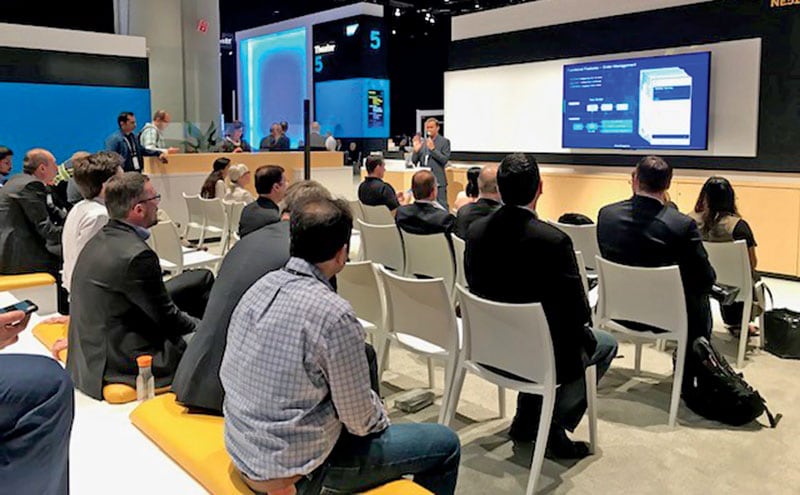
The leadership team recognized that changes to their technology platform were needed in order for the company to continue as a trailblazer in the personal care industry. They needed a way to drive sales, boost sales productivity and improve customer relations in the direct sales division. Sales reps needed reliable in-store order execution process and inventory fulfillment. Unfortunately, they had to work with an old system that could not keep pace with customer requests and changes.
“These sales reps go to the actual stores for retailers like Walmart, Target and Publix and take orders during their visits,” explained Saurabh Kumar, principal consultant at Infosys Limited. “They not only take the orders but also deliver orders based on inventory, which they have in their vans. Whenever they deplete inventory in the vans, they also raise stock orders, and those stock orders are delivered from the warehouses.”
Their needs seemed simple: optimize the process with a mobile solution and improve the in-store execution experience. However, in-store experience improvement meant reconfiguring how to take orders, complete tasks during store visits and handle the inventory fulfillment process. Behind the simple visible need was a complex underlying challenge.
The public care company decided to implement a sales cloud mobile app to realize operational cost savings, top-line growth and overall customer development. Beyond the technology, this solution required a deeper dive into the problems faced by the sales reps. “Imagine the life of a sales rep who walks from store to store and who has an eight-year-old Motorola handheld device, which is bulky and hard to carry,” said Kumar. “The legacy sales application was built on a Microsoft-customized solution, and extensibility was a problem because it cannot be exposed to Android and iOS.”
Further, the existing platform was inefficient for upgrades. There were many challenges to rolling out new solutions — both technical challenges and process-related ones — due to manual steps not integrated with the current system.
Corporate leaders selected SAP C4C (C/4HANA Sales Cloud) to replace its legacy mobile application. The company wanted a one-stop platform for its mobile sales representatives, who visit stores and generate orders.
“Sales cloud SAP C4/HANA software was implemented and sales reps were provided Apple iPhones as the hardware,” said Kumar. “A Honeywell scanner case is integrated with the iPhone as one combined unit to enable the reps to scan the products at the stores and pull that product information into the order.”
This process and technology program delivered a number of business benefits for the organization and its 100-member direct sales team. The smoother, faster order process contributed to incremental sales of $275,000 per year. The system also improved collaboration and delivered an intuitive in-store execution process, which moved the company close to its goal of creating a perfect store experience.
“Beyond the process improvements, the new system also eliminated the need for capital expenses and provided free upgrades and extensibility by SAP,” said Kumar. “Manual processes were automated, and new processes were also introduced to improve the sales rep efficiency and customer experience.”
For example, the process improves experience for territory managers during store visits. The standard visit solution in C4/HANA created orders for direct van delivery, a more natural way to generate shipping orders and a direct path to updates and signatures from managers. The system performs inventory fulfillment activities for sales reps. A mobile app with the C4 sales cloud program raises stock orders, which are sent to the warehouse immediately, and the sales rep can acknowledge receipt of the goods instantly. It is similar to email notifications.
Standard functionality was required with the sales cloud mobile app to streamline the ordering process for the sales rep. The rep can create a new order from a product list, with the ability to identify and delete duplicate items and change product prices. The sales rep can quickly align with the store manager to make sure the order is complete and ready for signature.
While standard processes improved performance for the mobile solution, the organizations’ specific needs also required customized processes and technology. These custom areas include the inventory fulfillment process, sales cloud, stock orders, inventory management and inventory reconciliation. “The first scenario is related to the stock order transfer, where the rep goes to the storage facility provided by the company,” said Kumar. “They stock inventory there, and stock order requests can be placed directly from the C4 application.”
Another functional feature is the physical inventory count, which happens between the rep and the administrator. The order is requested in the C4 mobile app and transferred to the administrator, who also has access to the C4 app. “It is extremely critical to make sure we do not impact the application performance and user experience,” said Kumar.
This process was not without challenges. While the tenant strategy called for a two-tier landscape C4C, the back-end S4 application was a three-tier landscape. “We mitigated this through an aggressive test plan and by making sure we point our sales cloud solution to the back-end development system periodically based on the testing cycles,” explained Kumar. “That’s how we achieved a sales cloud implementation with Personal Data Interchange deployments with a two-tenant landscape only.”
Another challenge was the possibility of problems related to product gaps, product issues or solution deployment. For these areas, collaboration with the SAP team was critical to success.
Scanners were an essential component of program success. While not perceived as cutting-edge tech, these devices are the physical link between the product and the underlying system. Scanners are not without their own integration risk, and during implementation some of the scanners did not work initially. Once the team notified SAP, they were able to quickly resolve the problem.
Quarterly software upgrades are necessary, and one was due just a week before the company’s “go-live” date. Steps were taken to move the production copy in advance, and the goal was to make sure the quarterly release did not cause problems with the customer’s plan. The added checks and controls in addition to the regression testing required processing through the C4 cloud solution. This is another example where close collaboration with the SAP team was required. As a result of focus and teamwork, the update and live component went smoothly.
The adoption of in-store execution and inventory fulfillment helped the organization achieve the efficient way to execute a way to order and fulfill inventory and serve customers more efficiently. “We achieved operational savings of $40,000 per year and incremental revenue growth of $275,000 per year,” said Kumar. “This was achieved by following our design principles and making sure that smooth order processing happens in the store that the user interface is responsive and that we provide better visibility.”
Our client achieved operational excellence and efficiencies using a business-focused program that relied on the technology of SAP Sales Cloud. Stakeholders adopted this enthusiastically because they received better reports, better sales rep experience and tools to support their store managers. Now, the personal care company has a stronger mobile-based ordering platform to help it focus on growth and deliver better solutions to customers through personal care.
Contributors
Infosys would like to acknowledge the contributions made by each of our esteemed panelists. Their insights and thought leadership are greatly appreciated and helped make SAPPHIRE NOW 2019 a richer experience for all participants.
Dinesh Rao
EVP – Head Global Services Enterprise Package Application Services, Infosys
Nikhil Balkundi
Senior Industry Principal, Infosys
Ram Srivas Battula
Principal Technology Architect, Infosys
Daniel Ferreira
CIO, Eurofarma
Frank Dorr
Managing Partner LATAM, Infosys Consulting
Sujesh K. C.
Senior Technology Architect-SAP, New Technology Services, Infosys
Saurabh Kumar
Principal Consultant, Infosys
Matt McCall
Global Integrated Business Planning Lead, Syngenta
Avi Mehta
Associate Partner, Infosys Consulting
